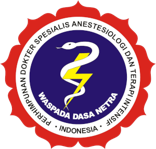Management of Intracranial Pressure Control in Reciprocal Grade 3 Astrocytoma Patient In Dr. Moewardi General Hospital Surakarta: Case Report
Abstract
Surgery in patients with astrocytoma is performed based on the size of the tumor in the brain and the functional status of the patients. Management of patients with intracranial hypertension can be guided by monitoring intracranial pressure (ICP) perioperatively. A variety of ventricular, intraparenchymal, and subdural equipment can be installed by neurosurgeons to provide ICP measurements.
We reported a 50-year-old female patient, with a complaint of having a speech disorder since four years ago. Preoperative physical examination showed GCS E4V5M6, patient's body mass index was 29.29 kg/m2 (obese). Patient’s physical status was assessed with ASA 3. There was no significant abnormality in laboratory examination. MRI Brain contrast examination showed solid cystic lesion in supratentorial left temporal lobe with size 2.3x3.5x4.7cm accompanied by broad perifocal edema in the left frontal, temporal and parietal lobe. The chest X-ray showed cardiomegaly and pneumonia. Electrocardiography showed normal sinus rhythm.
Craniotomy in patients with astrocytoma is performed based on the size of the tumor in the brain and the functional status of the patient. Preoperative evaluation for patients undergoing craniotomy should be carried out to determine the presence or absence of intracranial hypertension. In principle, postoperative management in the ICU is to control the respiratory system, optimize the cardiovascular system, and prevent possible complications.
Management of intracranial pressure control in reciprocal grade 3 astrocytoma patient should be paid attention to various things and consider the condition of the patients. Preoperative preparations, as well as perioperative and postoperative monitoring, should be carefully observed to prevent complications that will adversely affect patients.
Keywords
Full Text:
PDFReferences
1. Louis DN, Perry A, Wesseling P, et al. The 2021 WHO Classification of Tumors of the Central Nervous System: a summary. Neuro Oncol. 2021;23(8):1231-1251. doi:10.1093/neuonc/noab106
2. Lapointe S, Perry A, Butowski NA. Primary brain tumours in adults. Lancet (London, England). 2018;392(10145):432-446. doi:10.1016/S0140-6736(18)30990-5
3. Lamsal R, Rath GP. Pediatric neuroanesthesia. Curr Opin Anaesthesiol. Published online 2018.doi:10.1097/ACO.0000000000000630
4. Kurihara M, Nishimura S. Estimation of the head elevation angle that causes clinically important venous air embolism in a semi-sitting position for neurosurgery: a retrospective observational study. Fukushima J Med Sci. 2020;66(2):67-72. doi:10.5387/fms.2019-33
5. Kaplan K, Kaya Y, Kuncan M, Ertunç HM. Brain tumor classification using modified local binary patterns (LBP) feature extraction methods. Med Hypotheses. 2020;139:109696. doi:10.1016/j.mehy.2020.109696
6. Hirtz A, Rech F, Dubois-Pot-Schneider H, Dumond H. Astrocytoma: A Hormone-Sensitive Tumor? Int J Mol Sci. 2020;21(23). doi:10.3390/ijms21239114
7. Hasselblatt M, Jaber M, Reuss D, et al. Diffuse astrocytoma, IDH-wildtype: A dissolving diagnosis. J Neuropathol Exp Neurol. 2018;77(6):422-425. doi:10.1093/jnen/nly012
8. Gropper MA. Miller’s Anesthesia. (Gropper MA, ed.). Elsevier; 2020. doi:https://doi.org/10.1016/j.bja.2020.06.035
Refbacks
- There are currently no refbacks.








